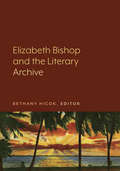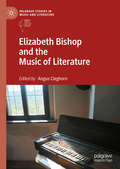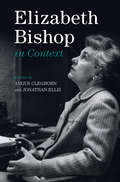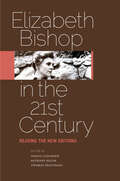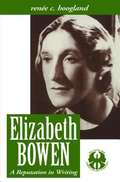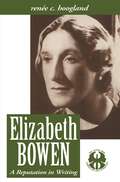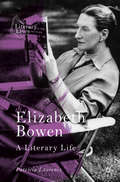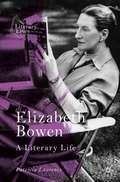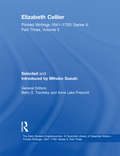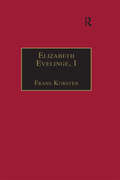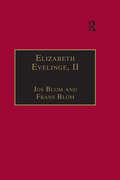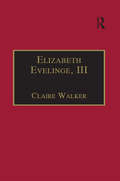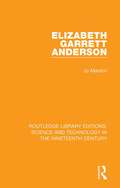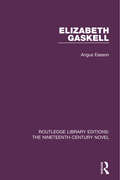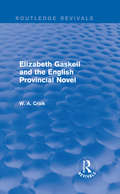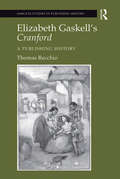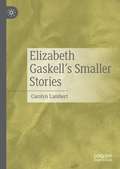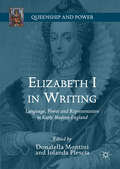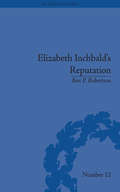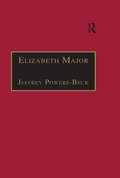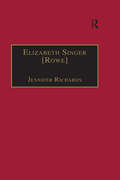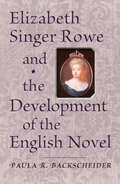- Table View
- List View
Elizabeth Bishop and the Literary Archive
by Bethany HicokIn a life full of chaos and travel, Elizabeth Bishop managed to preserve and even partially catalog, a large collection—more than 3,500 pages of drafts of poems and prose, notebooks, memorabilia, artwork, hundreds of letters to major poets and writers, and thousands of books—now housed at Vassar College. Informed by archival theory and practice, as well as a deep appreciation of Bishop’s poetics, the collection charts new territory for teaching and reading American poetry at the intersection of the institutional archive, literary study, the liberal arts college, and the digital humanities. The fifteen essays in this collection use this archive as a subject, and, for the first time, argue for the critical importance of working with and describing original documents in order to understand the relationship between this most archival of poets and her own archive. This collection features a unique set of interdisciplinary scholars, archivists, translators, and poets, who approach the archive collaboratively and from multiple perspectives. The contributions explore remarkable new acquisitions, such as Bishop’s letters to her psychoanalyst, one of the most detailed psychosexual memoirs of any twentieth century poet and the exuberant correspondence with her final partner, Alice Methfessel, an important series of queer love letters of the 20th century. Lever Press’s digital environment allows the contributors to present some of the visual experience of the archive, such as Bishop’s extraordinary “multi-medial” and “multimodal” notebooks, in order to reveal aspects of the poet’s complex composition process.
Elizabeth Bishop and the Music of Literature (Palgrave Studies in Music and Literature)
by Angus CleghornElizabeth Bishop and the Music of Literature brings together the latest understandings of how central music was to Bishop’s writing. This collection considers Bishop’s reworking of metrical and rhythmic forms of poetry; the increasing presence of prosaic utterances into speech-soundscapes; how musical poetry intones new modes of thinking through aural vision; how Bishop transforms traditionally distasteful tones of violence, banality, and commerce into innovative poetry; how her diverse, lifelong musical education (North American, European, Brazilian) affects her work; and also how her diverse musical settings have inspired global contemporary composers. The essays flesh out the missing elements of music, sound, and voice in previous research that are crucial to understanding how Bishop’s writing continues to dazzle readers and inspire artists in surprising ways.
Elizabeth Bishop at Work
by Eleanor CookCritics and biographers praise Elizabeth Bishop's poetry but have little to say about how it does its sublime work--in the ear and in the mind's eye. Eleanor Cook examines in detail Bishop's diction, syntax, rhythm, and meter, her acute sense of place, and her attention to the natural world. Writers, readers, and teachers will all benefit.
Elizabeth Bishop in Context (Literature in Context)
by Angus Cleghorn Jonathan EllisElizabeth Bishop is increasingly recognised as one of the twentieth century's most original writers. Consisting of thirty-five ground-breaking essays by an international team of authors, including biographers, literary critics, poets and translators, this volume addresses the biographical and literary inception of Bishop's originality, from her formative upbringing in New England and Nova Scotia to long residences in New York, France, Florida and Brazil. Her poetry, prose, letters, translations and visual art are analysed in turn, followed by detailed studies of literary movements such as surrealism and modernism that influenced her artistic development. Bishop's encounters with nature, music, psychoanalysis and religion receive extended treatment, likewise her interest in dreams and humour. Essays also investigate the impact of twentieth-century history and politics on Bishop's life writing, and what it means to read Bishop via eco-criticism, postcolonial theory and queer studies.
Elizabeth Bishop in the Twenty-First Century: Reading the New Editions
by Angus Cleghorn, Bethany Hicok and Thomas TravisanoIn recent years, a series of major collections of posthumous writings by Elizabeth Bishop--one of the most widely read and discussed poets of the twentieth century--have been published, profoundly affecting how we look at her life and work. The hundreds of letters, poems, and other writings in these volumes have expanded Bishop‘s published work by well over a thousand pages and placed before the public a "new" Bishop whose complexity was previously familiar to only a small circle of scholars and devoted readers. This collection of essays by many of the leading figures in Bishop studies provides a deep and multifaceted account of the impact of these new editions and how they both enlarge and complicate our understanding of Bishop as a cultural icon.Contributors: Charles Berger, Southern Illinois University, Edwardsville * Jacqueline Vaught Brogan, University of Notre Dame * Angus Cleghorn, Seneca College * Jonathan Ellis, University of Sheffield * Richard Flynn, Georgia Southern University * Lorrie Goldensohn * Jeffrey Gray, Seton Hall University * Bethany Hicok, Westminster College * George Lensing, University of North Carolina * Carmen L. Oliveira * Barbara Page, Vassar College * Christina Pugh, University of Illinois at Chicago * Francesco Rognoni, Catholic University in Milan * Peggy Samuels, Drew University * Lloyd Schwartz, University of Massachusetts, Boston * Thomas Travisano, Hartwick College * Heather Treseler, Worcester State University * Gillian White, University of Michigan
Elizabeth Bishop's Brazil
by Bethany HicokWhen the American poet Elizabeth Bishop arrived in Brazil in 1951 at the age of forty, she had not planned to stay, but her love affair with the Brazilian aristocrat Lota de Macedo Soares and with the country itself set her on another course, and Brazil became her home for nearly two decades. In this groundbreaking new study, Bethany Hicok offers Bishop’s readers the most comprehensive study to date on the transformative impact of Brazil on the poet’s life and art. Based on extensive archival research and travel, Elizabeth Bishop’s Brazil argues that the whole shape of Bishop’s writing career shifted in response to Brazil, taking on historical, political, linguistic, and cultural dimensions that would have been inconceivable without her immersion in this vibrant South American culture. Hicok reveals the mid-century Brazil that Bishop encountered--its extremes of wealth and poverty, its spectacular topography, its language, literature, and people--and examines the Brazilian class structures that placed Bishop and Macedo Soares at the center of the country’s political and cultural power brokers. We watch Bishop develop a political poetry of engagement against the backdrop of America’s Cold War policies and Brazil’s political revolutions. Hicok also offers the first comprehensive evaluation of Bishop’s translations of Brazilian writers and their influence on her own work. Drawing on archival sources that include Bishop’s unpublished travel writings and providing provocative new readings of the poetry, Elizabeth Bishop’s Brazil is a long-overdue exploration of a pivotal phase in this great poet’s life and work.
Elizabeth Bowen: A Reputation in Writing
by Renee C. HooglandImmensely popular during her lifetime, the Anglo-Irish writer Elizabeth Bowen (1899-1973) has since been treated as a peripheral figure on the literary map. If only in view of her prolific output--ten novels, nearly eighty short stories, and a substantial body of non- fiction--Bowen is a noteworthy novelist. The radical quality of her work, however, renders her an exceptional one. Surfacing in both subject matter and style, her fictions harbor a subversive potential which has hitherto gone unnoticed. Using a wide range of critical theories-from semiotics to psychoanalysis, from narratology to deconstruction-this book presents a radical re-reading of a selection of Bowen's novels from a lesbian feminist perspective. Taking into account both cultural contexts and the author's non-fictional writings, the book's main focus is on configurations of gender and sexuality. Bowen's fiction constitutes an exploration of the unstable and destabilizing effects of sexuality in the interdependent processes of subjectivity and what she herself referred to as so-called reality.
Elizabeth Bowen: A Reputation in Writing (The Cutting Edge: Lesbian Life and Literature Series)
by Renee Carine HooglandImmensely popular during her lifetime, the Ango-Irish writer Elizabeth Bowen (1899-1973) has since been treated as a peripheral figure on the literary map. If only in view of her prolific outputten novels, nearly eighty short stories, and a substantial body of non- fictionBowen is a noteworthy novelist. The radical quality of her work, however, renders her an exceptional one. Surfacing in both subject matter and style, her fictions harbor a subversive potential which has hitherto gone unnoticed. Using a wide range of critical theories-from semiotics to psychoanalysis, from narratology to deconstruction-this book presents a radical re-reading of a selection of Bowen's novels from a lesbian feminist perspective. Taking into account both cultural contexts and the author's non-fictional writings, the book's main focus is on configurations of gender and sexuality. Bowen's fiction constitutes an exploration of the unstable and destabilizing effects of sexuality in the interdependent processes of subjectivity and what she herself referred to as so-called reality.
Elizabeth Bowen: A Literary Life (Literary Lives)
by Patricia LaurenceElizabeth Bowen: A Literary Life reinvents Bowen as a public intellectual, propagandist, spy, cultural ambassador, journalist, and essayist as well as a writer of fiction. Patricia Laurence counters the popular image of Bowen as a mannered, reserved Anglo-Irish writer and presents her as a bold, independent woman who took risks and made her own rules in life and writing. This biography distinguishes itself from others in the depth of research into the life experiences that fueled Bowen’s writing: her espionage for the British Ministry of Information in neutral Ireland, 1940-1941, and the devoted circle of friends, lovers, intellectuals and writers whom she valued: Isaiah Berlin, William Plomer, Maurice Bowra, Stuart Hampshire, Charles Ritchie, Sean O’Faolain, Virginia Woolf, Rosamond Lehmann, and Eudora Welty, among others. The biography also demonstrates how her feelings of irresolution about national identity and gender roles were dispelled through her writing. Her vivid fiction, often about girls and women, is laced with irony about smooth social surfaces rent by disruptive emotion, the sadness of beleaguered adolescents, the occurrence of cultural dislocation, historical atmosphere, as well as undercurrents of violence in small events, and betrayal and disappointment in romance. Her strong visual imagination—so much a part of the texture of her writing—traces places, scenes, landscapes, and objects that subliminally reveal hidden aspects of her characters. Though her reputation faltered in the 1960s-1970s given her political and social conservatism, now, readers are discovering her passionate and poetic temperament and writing as well as the historical consciousness behind her worldly exterior and writing.
Elizabeth Bowen: A Literary Life (Literary Lives)
by Patricia LaurenceElizabeth Bowen: A Literary Life reinvents Bowen as a public intellectual, propagandist, spy, cultural ambassador, journalist, and essayist as well as a writer of fiction. Patricia Laurence counters the popular image of Bowen as a mannered, reserved Anglo-Irish writer and presents her as a bold, independent woman who took risks and made her own rules in life and writing. This biography distinguishes itself from others in the depth of research into the life experiences that fueled Bowen’s writing: her espionage for the British Ministry of Information in neutral Ireland, 1940-1941, and the devoted circle of friends, lovers, intellectuals and writers whom she valued: Isaiah Berlin, William Plomer, Maurice Bowra, Stuart Hampshire, Charles Ritchie, Sean O’Faolain, Virginia Woolf, Rosamond Lehmann, and Eudora Welty, among others. The biography also demonstrates how her feelings of irresolution about national identity and gender roles were dispelled through her writing. Her vivid fiction, often about girls and women, is laced with irony about smooth social surfaces rent by disruptive emotion, the sadness of beleaguered adolescents, the occurrence of cultural dislocation, historical atmosphere, as well as undercurrents of violence in small events, and betrayal and disappointment in romance. Her strong visual imagination—so much a part of the texture of her writing—traces places, scenes, landscapes, and objects that subliminally reveal hidden aspects of her characters. Though her reputation faltered in the 1960s-1970s given her political and social conservatism, now, readers are discovering her passionate and poetic temperament and writing as well as the historical consciousness behind her worldly exterior and writing.
Elizabeth Cellier: Printed Writings 1641–1700: Series II, Part Three, Volume 5 (The Early Modern Englishwoman: A Facsimile Library of Essential Works & Printed Writings, 1641-1700: Series II, Part Three)
by Mihoko SuzukiElizabeth Cellier, the scandalous celebrity known as the 'Popish midwife', became the focus of a large number of pamphlets in 1680: accounts of her two trials, her self-vindication, Malice Defeated, her opponent Thomas Dangerfield's rejoinder, and various anonymous satiric attacks against her. She was tried twice: the first time for the more serious charge of treason, and the second for libel, for publishing Malice Defeated. She was acquitted the first time, but found guilty the second, though her punishment was to be pilloried, not executed. She reemerges as the author of tracts on midwifery, proposing to James II the establishment of a professional guild of midwives. Her writings exhibit her remarkable determination to publish her accusations of judicial torture and her advocacy of the licensing of midwives as professional women, as well as exemplifying the importance of the printing press for enabling women to participate in the political public sphere.
Elizabeth Evelinge, I: Printed Writings 1500–1640: Series I, Part Three, Volume 3 (The Early Modern Englishwoman: A Facsimile Library of Essential Works & Printed Writings, 1500-1640: Series I, Part Three #Pt. 3)
by Frans KorstenThe history of the angelicall virgin glorious S.Clare (Douai 1635) is a translation by 'Sister Magdalen' of a work by the Franciscan priest François Hendricq, Vie admirable de madame S. Claire fondatrice des Pauvres Clairesses (1631). In its turn Hendricq's book is largely a translation of parts of Luke Wadding's Annales ordinis minorum ('Annals of the Franciscan Order'). These volumes include an account of the activities of the young woman, Clara Offreduccio di Favarone, one of the many followers of St. Francis of Assisi. In 1212 Clara was advised by St. Francis to withdraw to the monastery at San Damiano in Assisi. In this way St. Francis founded his Second Order, an order of religious women known as the Poor Clares. 'Sister Magdalen' has been identified as Elizabeth Evelinge who belonged to a dissident group of Poor Clares that left their English convent at Gravelines in 1627 and started a new convent at Aire in May 1629. The copy of her translation reproduced in this volume is that of Heythrop College, University of London.
Elizabeth Evelinge, II: Printed Writings 1500–1640: Series I, Part Three, Volume 5 (The Early Modern Englishwoman: A Facsimile Library of Essential Works & Printed Writings, 1500-1640: Series I, Part Three #Pt. 3)
by Jos BlomThe declarations and ordinances made upon the rule of our holy mother S.Clare is an English translation of papal pronouncements upon the rules governing the convents of the Franciscan Order of St Clare. Elizabeth Evelinge's 176-page English version was published by one of the most prolific presses of the 17th-century English Roman Catholic exiles, the English College Press at St Omer. The edition, which was presumably very limited, was meant for English nuns living in monasteries in Flanders and Northern France. At her death, Elizabeth Evelinge was described as having 'a more polish'd way of writing above her sex. Her translation of The declarations at the age of just 25, testifies to her skills. The copy of the text reproduced here is that held at the Franciscan Library at Killiney.
Elizabeth Evelinge, III: Printed Writings 1500–1640: Series I, Part Four, Volume 1 (The Early Modern Englishwoman: A Facsimile Library of Essential Works & Printed Writings, 1500-1640: Series I, Part Four)
by Claire WalkerElizabeth Evelinge, now firmly believed to have been the translator of The admirable life of the holy virgin S. Catharine of Bologna, entered the English Poor Clare monastery in Gravelines in 1620. After ongoing dissension at Gravelines, along with Catharine Bentley (originally believed to be the translator) she founded a new cloister at Aire. Evelinge served as abbess here for 25 years. Her 1621 translation of Catharine of Bologna's life and Spiritual weapons, with their exemplary advice about how to survive the temptations and conflicts of cloistered life, aimed at assisting the troubled English Poor Clares in their time of need. Whether designed to further the Franciscan cause within the cloister or simply to offer solace, the translation of this text occurred because of the dissension in the house at Gravelines. Moreover, it is possible that Catharine of Bologna represented so compelling a model of Poor Clare spirituality that Elizabeth Evelinge, whose piety and talents mirrored those of her subject, deemed herself too humble to ascribe her intellectual achievements to herself, which led to the debate about who translated the text.
Elizabeth Garrett Anderson (Routledge Library Editions: Science and Technology in the Nineteenth Century #5)
by Jo MantonFirst published in 1965. In 1865, a woman first obtained a legal qualification in this country as physician and surgeon. Elizabeth Garrett surprised public opinion by the calm obstinacy with which she fought for her own medical education and that of the young women who followed her. This full biography is based largely on unpublished material from the hospitals and medical schools where Elizabeth Garrett Anderson worked, and the private papers of the Garrett and Anderson families. This title will be of great interest to history of science students.
Elizabeth Gaskell: Electronic Edition (Routledge Library Editions: The Nineteenth-Century Novel #11)
by Angus EassonFirst published in 1979, this book looks at every aspect of the life and work of Elizabeth Gaskell, including her lesser known novels and writings — especially those concerning life in the industrial north of Victorian England. It shows how her work springs from a culture and society which pervades all she thought and wrote. An opening chapter explores her religion, culture, friendships and family. The major works are considered in turn and background material relevant to the novels’ industrial scenes is presented. The process of literary creation is charted in material drawn from letters and by examination of the manuscripts. Her short stories, journalism and letters are also considered.
Elizabeth Gaskell (Routledge Library Editions: The Nineteenth-Century Novel #26)
by John McVeaghFirst published in 1970, this study demonstrates both the range and essential unity of the works of Mrs. Gaskell. The author analyses the novels of social criticism, the biography of Charlotte Brontë and the novels of country life as distinct expressions of her genius, commenting on recurrent themes, typical methods of presentation and consistent attitudes as they appear in each of the works. The differences of subject and intention between the three kinds of writing will be seen in the extracts which indicate the range of her ability and interests. The final section summarises her range and success and failure. This book will be of interest to students of literature and sociological history.
Elizabeth Gaskell and the English Provincial Novel (Routledge Revivals)
by W. A. CraikFirst published in 1975, this book places Elizabeth Gaskell amongst the major novelists of the nineteenth-century. It considers how she has sometimes been overlooked, or admired for very few of her works, or for reasons that are not in fact central to her art. W. A. Craik looks at Gaskell’s full-length novels with three main purposes: to analyse her development as a novelist, her achievements, and the nature of her very original work; to see what she owes to earlier novelists, what she learns from them, and how far she is an innovator; and to put her in relation to those other novelists who write on similar themes with comparable aims. This book establishes Elizabeth Gaskelll’s excellence in comparison with her peers by demonstrating how far she extended the possibilities of the novel, both in materials and techniques.
Elizabeth Gaskell's Cranford: A Publishing History (Ashgate Studies In Publishing History: Manuscript, Print, And Digital Ser.)
by Thomas RecchioTracing the publishing history of Elizabeth Gaskell's Cranford from its initial 1851-53 serialization in Dickens's Household Words through its numerous editions and adaptations, Thomas Recchio focuses especially on how the text has been deployed to support ideas related to nation and national identity. Recchio maps Cranford's nineteenth-century reception in Britain and the United States through illustrated editions in England dating from 1864 and their subsequent re-publication in the United States, US school editions in the first two decades of the twentieth century, dramatic adaptations from 1899 to 2007, and Anglo-American literary criticism in the latter half of the twentieth century. Making extensive use of primary materials, Recchio considers Cranford within the context of the Victorian periodical press, contemporary reviews, theories of text and word relationships in illustrated books, community theater, and digital media. In addition to being a detailed publishing history that emphasizes the material forms of the book and its adaptations, Recchio's book is a narrative of Cranford's evolution from an auto-ethnography of a receding mid-Victorian English way of life to a novel that was deployed as a maternal model to define an American sensibility for early twentieth-century Mediterranean and Eastern European immigrants. While focusing on one novel, Recchio offers a convincing micro-history of the way English literature was positioned in England and the United States to support an Anglo-centric cultural project, to resist the emergence of multicultural societies, and to ensure an unchanging notion of a stable English culture on both sides of the Atlantic.
Elizabeth Gaskell’s Smaller Stories
by Carolyn LambertThis book re-locates Elizabeth Gaskell’s ‘smaller stories’ in the literary and cultural context of the nineteenth century. While Gaskell is recognised as one of the major novelists of her time, the short stories that make up a large proportion of her published work have not yet received the critical attention they deserve. This study re-claims them as an indispensable part of her literary output that enables us to better contextualize and assess her achievement holistically as a highly-skilled woman of letters. The periodicals in which Gaskell’s shorter pieces were published offer a microcosm of nineteenth-century society, and Gaskell took full advantage of the medium to apply a consistent and barbed challenge to cultural and gendered constructs of roles and social behaviour. Although her eminently readable prose still flows easily in her short stories, it is less likely to elide the sharp corners of domestic violence, the disabling experiences of women, the pain of death and loss, and the complications of family life.
Elizabeth I in Writing: Language, Power And Representation In Early Modern England (Queenship and Power)
by Donatella Montini Iolanda PlesciaThis collection investigates Queen Elizabeth I as an accomplished writer in her own right as well as the subject of authors who celebrated her. With innovative essays from Brenda M. Hosington, Carole Levin, and other established and emerging experts, it reappraises Elizabeth’s translations, letters, poems and prayers through a diverse range of approaches to textuality, from linguistic and philological to literary and cultural-historical. The book also considers Elizabeth as “authored,” studying how she is reflected in the writing of her contemporaries and reconstructing a wider web of relations between the public and private use of language in early modern culture. Contributions from Carlo M. Bajetta, Guillaume Coatelen and Giovanni Iamartino bring the Queen’s presence in early modern Italian literary culture to the fore. Together, these essays illuminate the Queen in writing, from the multifaceted linguistic and rhetorical strategies that she employed, to the texts inspired by her power and charisma.
Elizabeth Inchbald's Reputation: A Publishing and Reception History (The History of the Book #12)
by Ben P RobertsonThrough an examination of her complete works and public response to them, Robertson gauges the extent of Inchbald's reputation as the dignified Mrs Inchbald, as well as providing a clear sense of what it meant to be a female Romantic writer.
Elizabeth Major: Printed Writings 1641–1700: Series II, Part Two, Volume 6 (The Early Modern Englishwoman: A Facsimile Library of Essential Works & Printed Writings, 1641-1700: Series II, Part Two #Vol. 6)
by Jeffrey Powers-BeckElizabeth Major was inspired to write Honey on the Rod (1656) as a result of lameness brought on by a bout of fever in her mid-twenties. The experience left her fiercely devoted to her Christian religion, but also filled with indignation against the sins of nominal Christians. Honey on the Rod was written to comfort the afflicted and afflict the comfortable. The work is in two parts. The first is a lengthy prose meditation in the form of a dialogue between a 'Soul' and 'Consolation'. The second is a sequence of poems on conventional Calvinistic themes, scourging common vices and praising the humble soul that accepts God's rod of affliction. The speaking voice of Honey on the Rod is unmistakeably that of a woman and as such the work contributes a woman's voice to the devotional literature dominated by men in the seventeenth century. This facsimile edition reproduces the copy held in the British Library.
Elizabeth Singer [Rowe]: Printed Writings 1641–1700: Series II, Part Two, Volume 7 (The Early Modern Englishwoman: A Facsimile Library of Essential Works & Printed Writings, 1641-1700: Series II, Part Two #Pt. 2)
by Jennifer RichardsPrinted Writings 1641-1700: Series II, Part Two, consists of seven volumes of writings as follows: Volume 1: An Collins Volume 2: Alicia D'Anvers Volume 3: 'Eliza' Volume 4: Amey Hayward Volume 5: Anne Killigrew Volume 6: Elizabeth Major Volume 7: Elizabeth Singer [Rowe]
Elizabeth Singer Rowe and the Development of the English Novel
by Paula R. BackscheiderElizabeth Singer Rowe played a pivotal role in the development of the novel during the eighteenth century.Winner of the CHOICE Outstanding Academic Title of the Choice ACRLElizabeth Singer Rowe and the Development of the English Novel is the first in-depth study of Rowe’s prose fiction. A four-volume collection of her work was a bestseller for a hundred years after its publication, but today Rowe is a largely unrecognized figure in the history of the novel. Although her poetry was appreciated by poets such as Alexander Pope for its metrical craftsmanship, beauty, and imagery, by the time of her death in 1737 she was better known for her fiction. According to Paula R. Backscheider, Rowe's major focus in her novels was on creating characters who were seeking a harmonious, contented life, often in the face of considerable social pressure. This quest would become the plotline in a large number of works in the second half of the eighteenth century, and it continues to be a major theme today in novels by women.Backscheider relates Rowe’s work to popular fiction written by earlier writers as well as by her contemporaries. Rowe had a lasting influence on major movements, including the politeness (or gentility) movement, the reading revolution, and the Bluestocking society. The author reveals new information about each of these movements, and Elizabeth Singer Rowe emerges as an important innovator. Her influence resulted in new types of novel writing, philosophies, and lifestyles for women. Backscheider looks to archival materials, literary analysis, biographical evidence, and a configuration of cultural and feminist theories to prove her groundbreaking argument.
